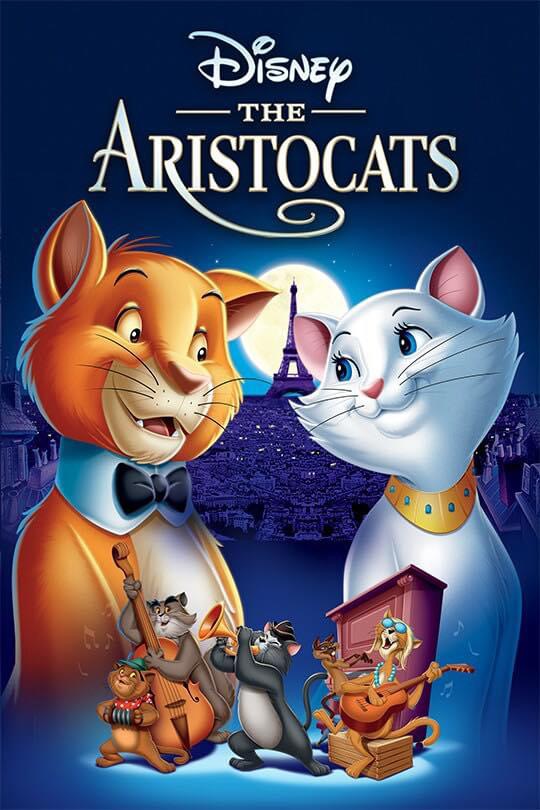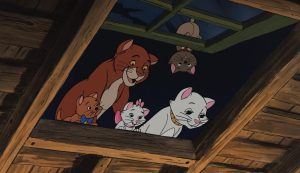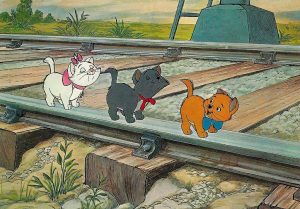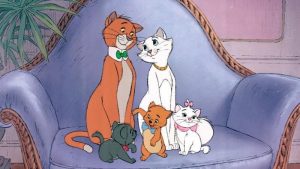The Aristocats (1970)

The Aristocats (1970) is a charming animated film from Walt Disney Productions, beloved for its playful humor, endearing characters, and jazzy soundtrack. Directed by Wolfgang Reitherman, this movie takes viewers to the streets of 1910 Paris, where they follow the journey of Duchess, a refined cat belonging to a wealthy elderly woman, and her three adorable kittens, Marie, Toulouse, and Berlioz. When the family’s greedy butler Edgar kidnaps the cats to claim his mistress’s fortune, they embark on a colorful adventure to find their way back home, encountering lively characters along the way.
As the first animated feature produced after Walt Disney’s death in 1966, The Aristocats represents the beginning of a new era for Disney. While the film’s production retains the studio’s hallmark qualities, it also reveals Disney’s evolving style, blending classic charm with a modern sensibility.
Suggested videos for you:
Plot and Themes
The story centers on Madame Adelaide Bonfamille, a retired opera singer in Paris who decides to leave her fortune to her beloved cats, Duchess and her three kittens, until their passing, at which point the inheritance will transfer to her butler, Edgar. Upon learning of this arrangement, Edgar, realizing he could be dead by the time he inherits anything, decides to eliminate the competition by getting rid of the cats.
Duchess and her kittens are then abandoned in the countryside by Edgar, setting off an adventure that introduces them to a variety of colorful characters, including the suave alley cat Thomas O’Malley. O’Malley takes on the role of their guide and protector as they make their way back to Paris, and a blossoming romance begins between him and Duchess, adding a sweet element to the story. Along the way, the characters learn about family, trust, and resilience, with O’Malley ultimately offering the kitten trio a father figure they lack.
The film’s main themes of family loyalty and courage are presented in a lighthearted way, suitable for young audiences. The cats’ determination to return home to Madame showcases their loyalty and love for her, despite their predicament. At the same time, Duchess’s willingness to welcome O’Malley into their lives suggests the importance of embracing new family connections. Themes of love, acceptance, and courage resonate throughout the story without overpowering the film’s light-hearted tone, making it both touching and entertaining.
Characters and Performances
The Aristocats is full of memorable characters, from the cultured, elegant Duchess (voiced by Eva Gabor) to the smooth-talking, streetwise Thomas O’Malley (voiced by Phil Harris). Duchess is a refined, loving mother who cares deeply for her kittens and is torn between her loyalty to Madame and her growing affection for O’Malley. Eva Gabor’s voice performance perfectly captures Duchess’s grace and maternal warmth, lending authenticity to her character.
Thomas O’Malley is one of Disney’s most charismatic characters, with Phil Harris imbuing him with a laid-back, confident charm. As a free-spirited alley cat, O’Malley has a rough edge that contrasts with Duchess’s sophistication, yet he is quick to assume the role of protector and mentor to the kittens. Harris’s performance gives O’Malley a warm, jazzy personality, helping to establish him as the heart of the film.
The kittens—Marie, Toulouse, and Berlioz—add an extra dose of cuteness and humor, each with a distinct personality. Marie, the most proper of the three, is often prim and ladylike, while Toulouse, inspired by his admiration for alley cats, has a bit of a wild streak. Berlioz, the pianist, is more subdued but has a mischievous side. The kittens’ interactions, especially their playful bickering, add warmth and humor to the film.
Edgar, the bumbling butler and the film’s primary antagonist, is a surprisingly sympathetic villain. Though his actions are motivated by greed, his schemes are clumsy, and he lacks the malevolent qualities of many Disney villains. His scenes, which often depict his interactions with a horse and two dogs, Napoleon and Lafayette, provide some of the movie’s most humorous moments.
Supporting characters like Scat Cat and his gang of jazz-playing alley cats add a unique flavor to the movie. Scat Cat, voiced by Scatman Crothers, is O’Malley’s friend and adds a jazzy, lively energy to the film. His band of cats, each with a distinct musical instrument and personality, contributes to one of the film’s most iconic scenes: the performance of “Ev’rybody Wants to Be a Cat.”
Animation and Art Style
The Aristocats features Disney’s distinctive animation style from the early 1970s, with its hand-drawn aesthetic and watercolor-like backgrounds. The animators used the xerography technique, which gives the film a sketchy, almost rough-around-the-edges look, particularly evident in the outlines of characters. This technique was also used in 101 Dalmatians and The Jungle Book, giving The Aristocats a slightly less polished but nonetheless charming appearance.
Paris is beautifully depicted with detailed backgrounds, showing cozy streets, countryside vistas, and intricate interiors that lend a sense of place to the film. From Madame’s ornate mansion to the colorful, cluttered settings of the alley cats, each scene feels rich with detail and atmosphere. The animators managed to blend a sense of refined elegance with the rustic and lively underworld of Parisian alleys.
The film’s animation truly shines in its musical sequences. The “Ev’rybody Wants to Be a Cat” scene is vibrant and colorful, with wild color shifts and dance sequences that feel almost psychedelic. This sequence, featuring neon colors and expressive, stylized animation, gives the film an injection of lively energy, reflecting the spontaneous, carefree spirit of jazz music.
Music and Soundtrack
The soundtrack of The Aristocats, composed by George Bruns, adds an extra layer of charm to the movie. The opening song, “The Aristocats,” sets a playful and whimsical tone, while the iconic “Ev’rybody Wants to Be a Cat” brings an infectious energy that has made it one of Disney’s most memorable songs. Sung by Scat Cat and his band, the song captures the essence of the jazz era and celebrates the film’s central idea of embracing individuality and freedom.
Bruns’s score is heavily influenced by jazz, fitting the film’s Parisian setting and adding to the overall mood of the story. The music complements the characters’ personalities—Duchess’s theme is gentle and refined, while O’Malley’s has a jazzy, carefree feel that reflects his personality. The soundtrack elevates the film’s energy and contributes to its timeless appeal, particularly with “Ev’rybody Wants to Be a Cat,” which has become synonymous with the film itself.
Criticism
Despite its many strengths, The Aristocats does have some dated elements that may not resonate as well with modern audiences. Certain characterizations, like the racial stereotypes present in the jazz band scene, can be uncomfortable to watch today. Disney has since acknowledged these depictions, and the scene is often discussed within the context of evolving social attitudes toward cultural sensitivity in media.
Another criticism is that the film’s story lacks some of the depth seen in other Disney classics. Compared to the sweeping emotional journeys in films like The Lion King or Beauty and the Beast, The Aristocats is a light-hearted, straightforward adventure without a particularly profound or complex plot. While this simplicity is part of its charm, some may find it less engaging than Disney’s more ambitious, layered narratives.
Additionally, while the character of Edgar provides comic relief, his motives are relatively simplistic. He doesn’t pose a serious threat to Duchess and her kittens, which reduces the tension in the film and makes it feel more like a series of fun vignettes than a suspenseful, cohesive story.
Conclusion
The Aristocats is a delightful animated film that combines the timeless charm of Disney storytelling with a vibrant jazz-infused soundtrack. It may not have the epic storytelling or emotional weight of other Disney classics, but its simplicity and warmth give it a special place in the Disney canon. The characters, particularly Duchess, O’Malley, and the kittens, are memorable and endearing, and the animation style has a nostalgic appeal that captures the spirit of 1970s Disney.
With its unique Parisian setting, engaging characters, and catchy jazz numbers, The Aristocats remains a beloved family film. Though it reflects some of the cultural attitudes of its time, it also celebrates individuality, family, and resilience. Its enduring popularity proves that even a simple story can leave a lasting impact when crafted with humor, heart, and a touch of jazz. For many, The Aristocats is a nostalgic journey back to childhood, and it continues to delight new generations with its upbeat, playful energy.










